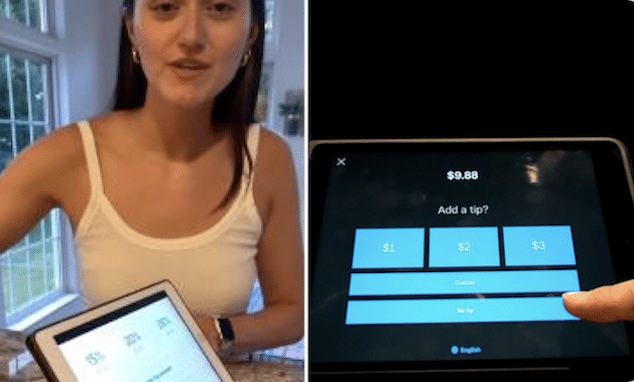

Self checkout machines now ask customers to tip – as employers reconfigure the bottom line as some claim a bid to get the public to increasingly subsidize worker pay. But will customers capitulate to what some call emotional blackmail or put their foot down?
Even the machines want to be tipped. A report has told of self checkout machines now prompting customers to tip. But will you? And who will be looking over your shoulder in case you decide not to?
In a bid to increase the bottom line and possibly subsidise worker pay, businesses are increasingly introducing new options for tipping at self-checkout machines, putting even more pressure on customers amid rising inflation costs.
‘They’re cutting labor costs by doing self-checkout. So what’s the point of asking for a tip? And where is it going?’
Despite having zero interaction with employees during transactions, self-checkout machines at places such as coffee shops, bakeries, airports and sports stadiums are giving customers the option to leave the typical 20% tip, according to a report from the Wall Street Journal.
Business owners believe that the prompt for a tip can boost staff pay and increase gratuities — but customers are questioning where and to whom the extra cash is going, considering self-checkout is done, well, by yourself.
‘They’re cutting labor costs by doing self-checkout. So what’s the point of asking for a tip? And where is it going?’ Ishita Jamar, a senior at American University in Washington, DC, who has noticed more self-serve tip cues, told WSJ.
Tipping researchers claim this is a sly way for companies to put the responsibility of paying employees on the customer rather than increasing employee salaries themselves.
William Michael Lynn, a professor of consumer behavior and tip culture at Cornell University’s Nolan School of Hotel Administration, told the WSJ that businesses are ‘taking advantage of an opportunity.’
Whose really keeping the tips?
The self-checkout gratuity option is an example of ‘tip creep’ — a phenomenon that prompts customers to leave higher tips in transactional situations.
Self-tipping is viewed by many customers as a way to guilt-trip the person into tipping on something when they typically wouldn’t.
‘Just the prompt, in general, is a bit of emotional blackmail,’ Garrett Bemiller, 26, who works in public relations in Manhattan, told WSJ after he was asked to add a 10% to 20% tip on his $6 water bottle at an airport self-checkout machine.
Yes kids, your airport water bottle is about to set you back anywhere from $6.60 to $7.20. Drink every drop very slowly….
The companies surveyed by the WSJ insist the tipping prompts are completely optional, and that the extra gratuity is split between all employees.
However, experts say that tips at a self-checkout machine might never even get to an actual employee since protections to tipped workers in the federal Fair Labor Standards Act don’t extend to machines, according to WSJ.
What other salaries can customers be expected to subdisize in the future?
Lehigh University associate professor Holona Ochs said self-checkout tipping ‘exploits the high adherence to tipping norms as a way to generate more revenue for the company.’
The influx of tipping options has sparked lots of debate with customers online, especially for places like Starbucks.
The option to tip by credit card at Starbucks was introduced in September 2022 and received mixed reviews from both customers and employees — the latter of whom admitted they feel embarrassed to ask for a tip on what is, essentially, fast food.
Research has shown that digital tipping options usually result in customers leaving a tip from 18% to 30% and higher, though many say they refuse to tip for fast food and self-serve experiences.
Of course one can only wonder how far the tipping culture will extend, and whether medical patients might now expect a ‘friendly’ prompt so medics can make sure they don’t die on the operating table, or how about airline pilots holding out their hat before they take off, to ensure a smooth friendly flight?






